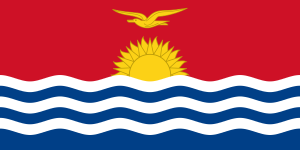Local Group: 350 KiriCAN
“Both western science and traditional science must travel together to build the resilience of our people in the Pacific.”– Pelenise Alofa, 350 KiriCAN
What climate changes are occurring in Kiribati, and what’s next?
- The surrounding ocean is getting more acidic: Such acidity affects the ability of corals and organisms to construct their skeletons. Without these organisms, the local ecosystem’s balance is put at risk.
- The sea level is rising: The sea around Kiribati has risen by between 1-4mm per year since 1993. While this is not as much as some surrounding islands, Kiribati is a very low lying coral atoll island, so small increases are significant if the island’s coral system cannot adjust to these changing conditions, and “keep up” with the sea level rise. This is potentially devastating for both the population’s safety and income. Increased sea levels leave the country more vulnerable to the high king tides which already cause flooding, while the coconut trees many rely on for income are sensitive to the increasingly saline groundwater.
- Temperatures have increased: Since 1950, temperatures at the country’s capital city Tarawa have increased at a rate of 0.18°C per decade, and are predicted to continue increasing.
- More very hot and very wet days: Models predict that Kiribati will experience more very hot days, and have more days of extreme rainfall. While projections also show drought may occur less often, increased rainfall puts regions of the country at increased risk of flooding.
——————————————————————
More detailed information from the Australian Government’s ‘Pacific Climate Change Science Program’ can be downloaded here –> Kiribati Climate Change Factsheet PDF.
What are the Kiribati Governments climate change policies?
Kiribati’s Government has a section of their website dedicated to climate change. The website has information on Kiribati’s climate, the effects of climate change, the actions the government has and will take to combat these effects, and the Government’s climate change adaptation program. The website can be viewed by clicking on any of the hyperlinks listed, or by clicking here.
——————————————————————
How do I Contact 350 KiriCAN?
You can email any of the following: [email protected], [email protected] or [email protected] if you have any questions, or would like information about climate change in Kiribati, or how you can get involved and contribute to the cause.
We’re currently in contact with a number of our team coordinators, representatives and volunteers on the ground in the Pacific Region – compiling information on the key climate issues facing the country, what our teams are doing locally, and how local groups are standing up and confronting the challenge of climate change.
As we compile more information, this link will be appropriately updated. So check back soon!
350 Pacific team

